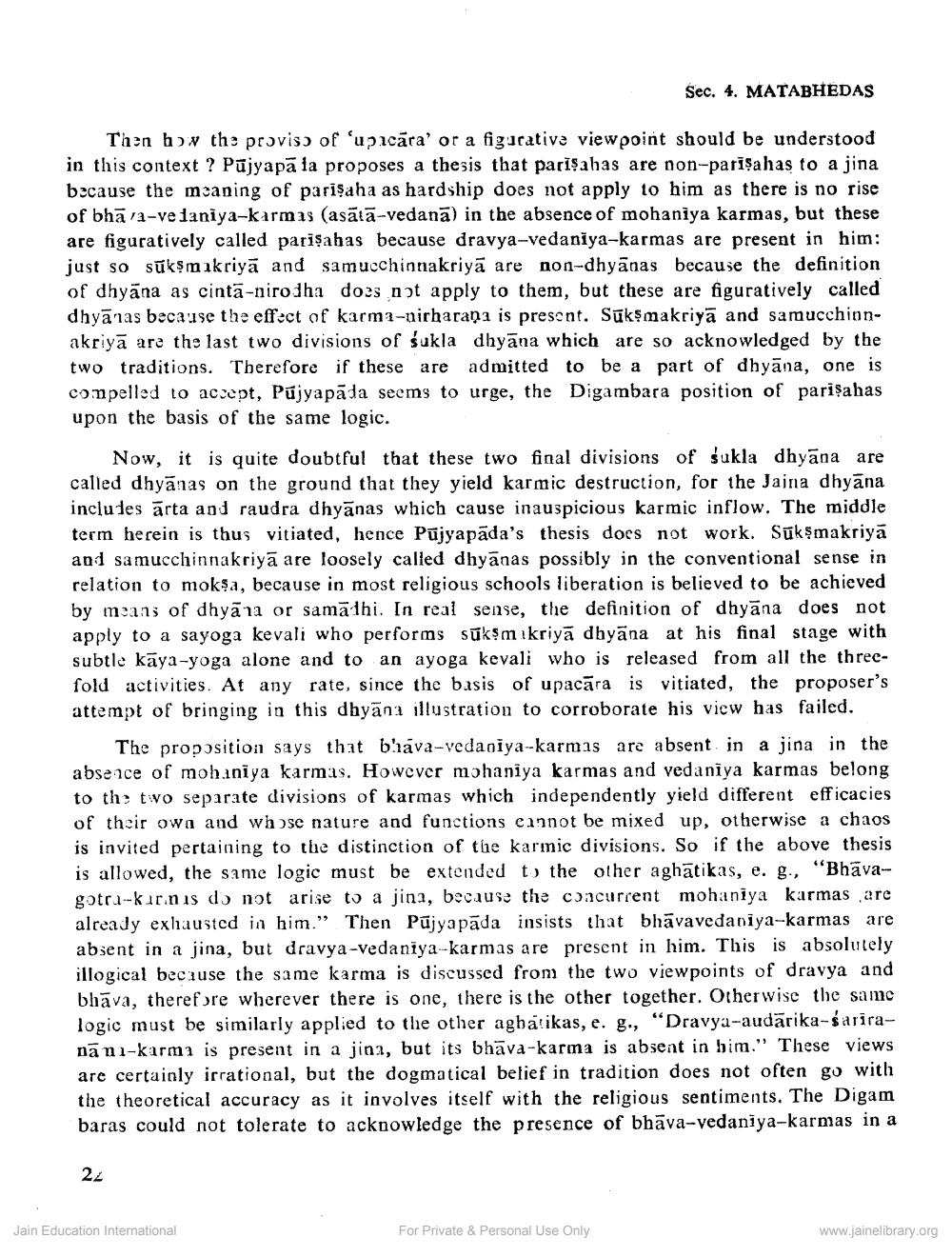________________
Sec. 4. MATABHEDAS
Then bow the provis) of 'upicāra' or a figurative view point should be understood in this context ? Pūjyapā la proposes a thesis that parişahas are non-parişahas to a jina because the meaning of parişaha as hardship does not apply to him as there is no rise of bhāra-velaniya-karmas (asātā-vedana) in the absence of mohaniya karmas, but these are figuratively called parişahas because dravya-vedaniya-karmas are present in him: just so sūksmakriya and samucchinnakriyā are non-dhyānas because the definition of dhyāna as cintā-nirodha does not apply to them, but these are figuratively called dhyānas because the effect of karma-nirharani is present. Sūksmakriya and samucchionakriyā are the last two divisions of śukla dhyāna which are so acknowledged by the two traditions. Therefore if these are admitted to be a part of dhyāna, one is compelled to accept, Pujyapāda seems to urge, the Digambara position of parişahas upon the basis of the same logic.
Now, it is quite doubtful that these two final divisions of sukla dhyāna are called dhyānas on the ground that they yield karmic destruction, for the Jajna dhyāna includes ārta and raudra dhyānas which cause inauspicious karmic inflow. The middle term herein is thus vitiated, hence Pūjyapada's thesis does not work. Sūkşmakriya and samucchinnakriyā are loosely called dhyānas possibly in the conventional sense in relation to moksa, because in most religious schools liberation is believed to be achieved by means of dhyān or samālhi. In real sense, the definition of dhyāna does not apply to a sayoga kevali who performs sūksmakriyā dhyāna at his final stage with subtle kāya-yoga alone and to an ayoga kevali who is released from all the threefold activities. At any rate, since the basis of upacāra is vitiated, the proposer's attempt of bringing in this dhyāna illustration to corroborate his view has failed.
The proposition says that bhava-vedaniya-karmas are absent in a jina in the absence of mobaniya karmas. However möhaniya karmas and vedaniya karmas belong to the two separate divisions of karmas which independently yield different efficacies of their own and whose nature and functions eannot be mixed up, otherwise a chaos is invited pertaining to the distinction of the karmic divisions. So if the above thesis is allowed, the same logic must be extended to the other aghātikas, e. g., "Bhāvagotru-kirnis do not arise to a jina, because the concurrent mohaniya karmas are already exhausted in him.” Then Pūjyapada insists that bhāvavedaniya-karmas are absent in a jina, but dravya-vedaniya-karmas are present in him. This is absolutely illogical because the same karma is discussed from the two viewpoints of dravya and bhāva, therefore wherever there is one, there is the other together. Otherwise the same logic must be similarly applied to the other aghalikas, e. g., "Dravya-audarika-Śariranāni-karma is present in a jina, but its bhāva-karma is absent in him." These views are certainly irrational, but the dogmatical belief in tradition does not often go with the theoretical accuracy as it involves itself with the religious sentiments. The Digam baras could not tolerate to acknowledge the presence of bhāva-vedaniya-karmas in a
22
Jain Education International
For Private & Personal Use Only
www.jainelibrary.org




